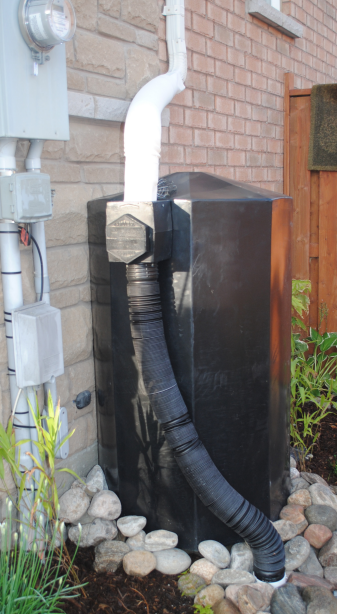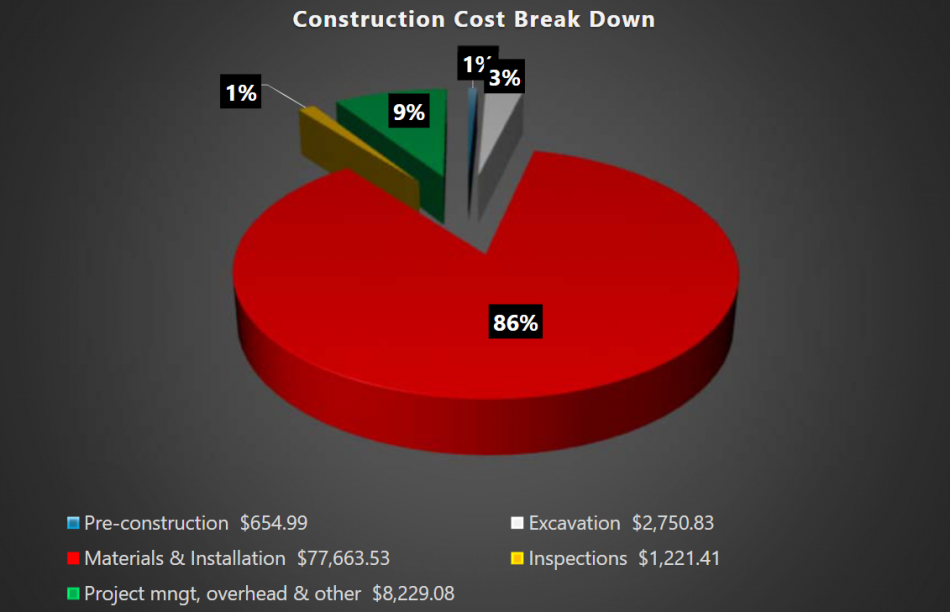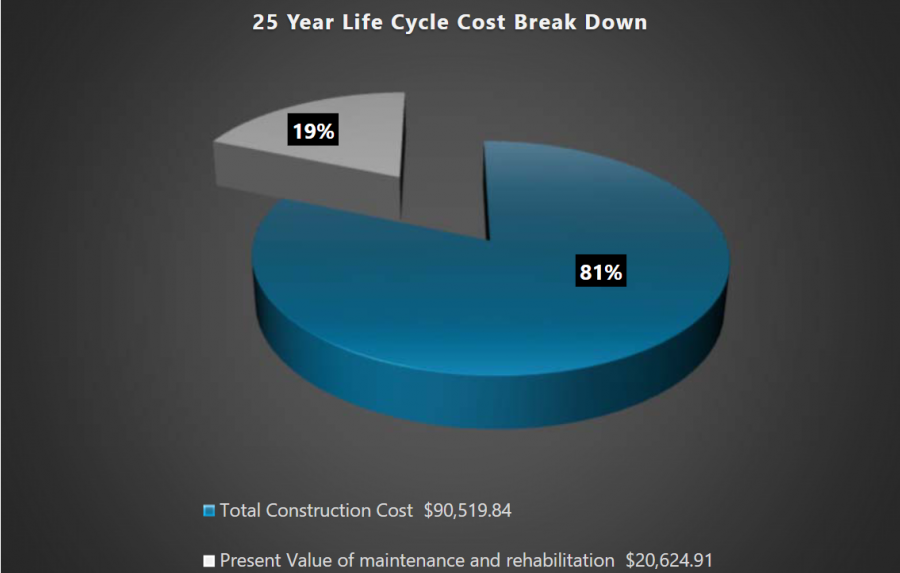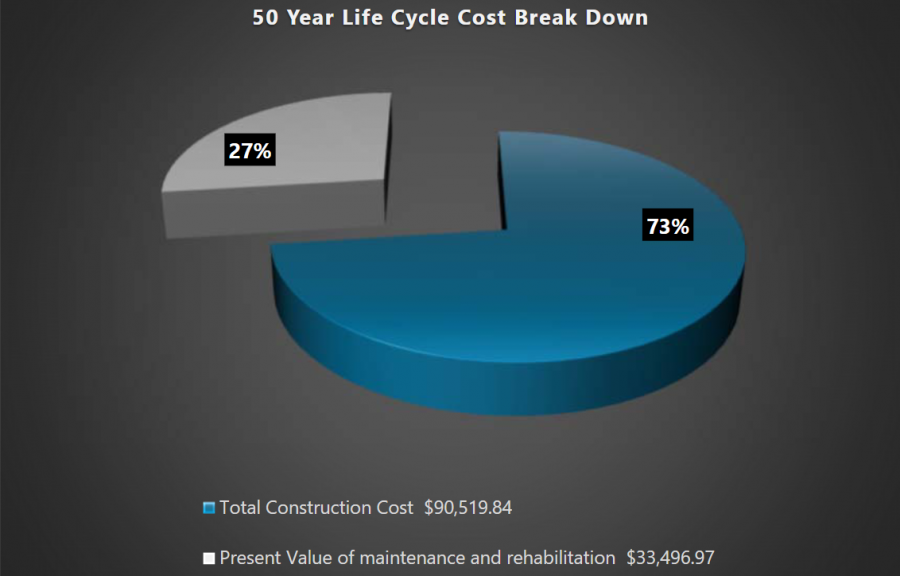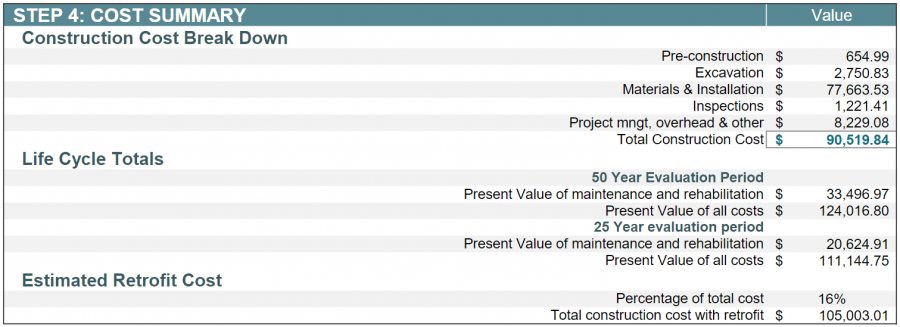Difference between revisions of "Rainwater Harvesting & Cisterns: Life Cycle Costs"
Dean Young (talk | contribs) |
|||
| (13 intermediate revisions by 2 users not shown) | |||
| Line 7: | Line 7: | ||
==Design Assumptions== | ==Design Assumptions== | ||
| − | [[Rainwater harvesting|Rainwater harvesting (RWH)]] is ideal for sites that cannot infiltrate water (e.g. contaminated soils, WHPAs, IPZs, etc.) | + | [[Rainwater harvesting|Rainwater harvesting (RWH)]] is ideal for high density, zero-lot-line developments, large garden and landscape areas, and sites that cannot infiltrate water (e.g. contaminated soils, WHPAs, IPZs, etc.). Components include: catchment area (e.g. rooftop), pretreatment filter to remove coarse debris, cistern storage, and a connecting pipe network. Additional components include pumps to lift water to higher elevations, additional water filtration and treatment. <br> |
Design and operation and maintenance program assumptions used to generate the cost estimate are based on tool default values and the following STEP recommendations: | Design and operation and maintenance program assumptions used to generate the cost estimate are based on tool default values and the following STEP recommendations: | ||
* Total daily water use of 2,000 L per day (tool default). | * Total daily water use of 2,000 L per day (tool default). | ||
* User specified storage tank capacity of 50,000 L. | * User specified storage tank capacity of 50,000 L. | ||
| − | |||
* Operation and maintenance (O&M) cost estimates assume annual inspections and cistern pump tests, removal of trash and debris from rooftop and pretreatment filter four times a year, and cleaning of cistern and replacement of pump and pressure tank every five years. Verification inspections are included every 5 years to confirm adequate maintenance. | * Operation and maintenance (O&M) cost estimates assume annual inspections and cistern pump tests, removal of trash and debris from rooftop and pretreatment filter four times a year, and cleaning of cistern and replacement of pump and pressure tank every five years. Verification inspections are included every 5 years to confirm adequate maintenance. | ||
===Notes=== | ===Notes=== | ||
| − | * | + | * Two (2) German-style in-line filters and precast concrete containment structures are included to provide pretreatment of roof runoff. |
* The tool calculates costs for new (greenfield) development contexts and includes costs for contractor overhead and profit, material, delivery, labour, equipment (rental, operating and operator costs), hauling and disposal. | * The tool calculates costs for new (greenfield) development contexts and includes costs for contractor overhead and profit, material, delivery, labour, equipment (rental, operating and operator costs), hauling and disposal. | ||
** Land value and equipment mobilization and demobilization costs are not included, assuming BMP construction is part of overall development site construction. | ** Land value and equipment mobilization and demobilization costs are not included, assuming BMP construction is part of overall development site construction. | ||
| Line 28: | Line 27: | ||
==Construction Costs== | ==Construction Costs== | ||
| − | [[File:Construction Breakdown RWH No Infil.PNG|thumb|center|950px|'''Construction Costs Per Unit Drainage Area (CAD$/m<sup>2</sup>) - No Infiltration Design, 25 mm Treatment''']] | + | [[File:Construction Breakdown RWH No Infil 2023.PNG|thumb|center|950px|'''Construction Costs Per Unit Drainage Area (CAD$/m<sup>2</sup>) - No Infiltration Design, 25 mm Treatment''']] |
| − | |||
<small>'''Note:''' Please click on each image to enlarge to view associated construction cost estimates.</small><br> | <small>'''Note:''' Please click on each image to enlarge to view associated construction cost estimates.</small><br> | ||
| − | Above you can find a | + | Above you can find a breakdown of construction costs by expense type for the 50,000 L below-ground concrete cistern design configuration. |
| − | |||
| − | The Material & Installation expenses represent the largest portion of total construction costs ( | + | The Material & Installation expenses represent the largest portion of total construction costs (86%). |
==Life Cycle Costs== | ==Life Cycle Costs== | ||
| − | Below are capital and life cycle cost estimates for | + | Below are capital and life cycle cost estimates for the below-ground concrete cistern design configuration over 25- and 50-year time periods. The estimates of maintenance and rehabilitation (life cycle) costs represent net present values. Operation and maintenance costs are predicted to represent 19% of total life cycle costs over the 25-year evaluation period, and increase to 27% of total life cycle costs over the 50-year period, due to periodic cleaning of cistern tank and replacing of components (pump and pressure tank). |
===25-Year life cycle cost break down=== | ===25-Year life cycle cost break down=== | ||
| − | [[File:25yr LCCT RWH No Infil.PNG|thumb|center|900px|'''Rainwater Harvesting: No Infiltration''']] | + | [[File:25yr LCCT RWH No Infil 2023.PNG|thumb|center|900px|'''Rainwater Harvesting: No Infiltration''']] |
<small>'''Note:''' Click on each image to enlarge to view associated life cycle cost estimate.</small><br> | <small>'''Note:''' Click on each image to enlarge to view associated life cycle cost estimate.</small><br> | ||
| + | </br> | ||
===50-Year life cycle cost break down=== | ===50-Year life cycle cost break down=== | ||
| − | [[File:50yr LCCT RWH No Infil.PNG|thumb|center|900px|'''Rainwater Harvesting: No Infiltration''']] | + | [[File:50yr LCCT RWH No Infil 2023.PNG|thumb|center|900px|'''Rainwater Harvesting: No Infiltration''']] |
<small>'''Note:''' Click on each image to enlarge to view associated life cycle cost estimate.</small><br> | <small>'''Note:''' Click on each image to enlarge to view associated life cycle cost estimate.</small><br> | ||
==Cost Summary Tables== | ==Cost Summary Tables== | ||
| − | Total life cycle cost | + | Total life cycle cost estimate over the 50 year evaluation period for the below-ground concrete cistern design configuration is ($124,016.80), making it one of the cheapest LID BMP options.<br> |
| − | === | + | ===No Infiltration=== |
| − | [[File:RWH rain barrel.PNG| | + | [[File:RWH rain barrel.PNG|700px|thumb|A residential [[rain barrels|rain barrel]] collecting roofwater from the house installed with a diverter to ensure water does not overflow the system when full and allows water to instead bypass the barrel and enter directly into the storm sewer through a storm lateral or enter an on site [[dry swale]] or [[infiltration trench]], if installed.]] |
| − | [[File:Design Table RWH No Infil.PNG| | + | [[File:Design Table RWH No Infil 2023.PNG|900px]]<br> |
</br> | </br> | ||
Latest revision as of 21:33, 17 January 2023
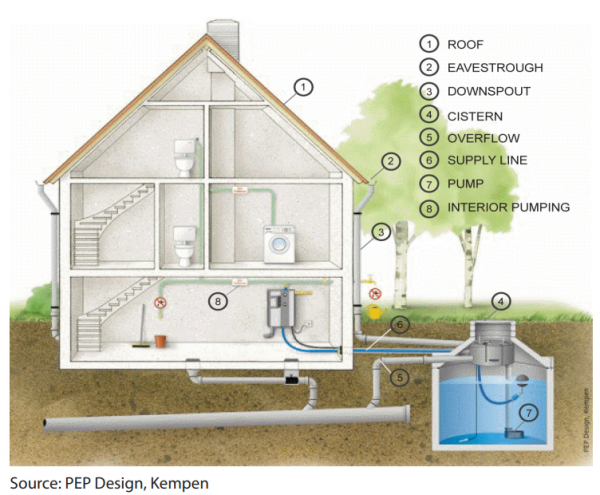
Overview[edit]
Rainwater harvesting is the process of intercepting, conveying and storing rainfall for future use. The term “rainwater harvesting” (RWH) is used herein to refer to capturing rainfall onto rooftops (i.e. “roofwater”) and stormwater runoff from the ground surface (i.e. “stormwater”), and then reusing for irrigation or other greywater-approved uses. The rain that falls upon a catchment surface, such as a roof, is collected and conveyed into a storage facility. Storage tanks, a common method for storage, range in size from rain barrels for residential land uses (typically 190 to 400 litres in size), to large cisterns for industrial, commercial and institutional land uses. A typical pre-fabricated cistern can range from 750 to 50,000 litres in size. STEP has prepared a life cycle cost estimate for a 50,000 L below-ground concrete cistern design configuration, based on a 2,000 m2 roof drainage area and runoff control target of 25 mm depth, for comparison which can be viewed below. To generate your own life cycle cost estimates customized to the development context, design criteria, and constraints applicable to your site, access the updated LID Life Cycle Costing Tool (LCCT) here.
Design Assumptions[edit]
Rainwater harvesting (RWH) is ideal for high density, zero-lot-line developments, large garden and landscape areas, and sites that cannot infiltrate water (e.g. contaminated soils, WHPAs, IPZs, etc.). Components include: catchment area (e.g. rooftop), pretreatment filter to remove coarse debris, cistern storage, and a connecting pipe network. Additional components include pumps to lift water to higher elevations, additional water filtration and treatment.
Design and operation and maintenance program assumptions used to generate the cost estimate are based on tool default values and the following STEP recommendations:
- Total daily water use of 2,000 L per day (tool default).
- User specified storage tank capacity of 50,000 L.
- Operation and maintenance (O&M) cost estimates assume annual inspections and cistern pump tests, removal of trash and debris from rooftop and pretreatment filter four times a year, and cleaning of cistern and replacement of pump and pressure tank every five years. Verification inspections are included every 5 years to confirm adequate maintenance.
Notes[edit]
- Two (2) German-style in-line filters and precast concrete containment structures are included to provide pretreatment of roof runoff.
- The tool calculates costs for new (greenfield) development contexts and includes costs for contractor overhead and profit, material, delivery, labour, equipment (rental, operating and operator costs), hauling and disposal.
- Land value and equipment mobilization and demobilization costs are not included, assuming BMP construction is part of overall development site construction.
- Design and Engineering cost estimates are not calculated by the tool and must be supplied by the user.
- The tool adds 10% contingency and additional overhead as default.
- All cost estimates are in Canadian dollars and represent the net present value (NPV) as the tool takes into account average annual interest and discount rates over the 25 and 50 year operating life cycle periods.
- Unit costs are based on 2018 RSMeans standard union pricing.
- Additional costs associated with retrofit or redevelopment contexts is assumed to be 16% of the cost estimate for new (greenfield) construction contexts.
- Retrofit construction cost estimates are included in the 'Costs Summary' section for comparison.
- Retrofit construction cost estimates are included in the 'Costs Summary' section for comparison.
Construction Costs[edit]
Note: Please click on each image to enlarge to view associated construction cost estimates.
Above you can find a breakdown of construction costs by expense type for the 50,000 L below-ground concrete cistern design configuration.
The Material & Installation expenses represent the largest portion of total construction costs (86%).
Life Cycle Costs[edit]
Below are capital and life cycle cost estimates for the below-ground concrete cistern design configuration over 25- and 50-year time periods. The estimates of maintenance and rehabilitation (life cycle) costs represent net present values. Operation and maintenance costs are predicted to represent 19% of total life cycle costs over the 25-year evaluation period, and increase to 27% of total life cycle costs over the 50-year period, due to periodic cleaning of cistern tank and replacing of components (pump and pressure tank).
25-Year life cycle cost break down[edit]
Note: Click on each image to enlarge to view associated life cycle cost estimate.
50-Year life cycle cost break down[edit]
Note: Click on each image to enlarge to view associated life cycle cost estimate.
Cost Summary Tables[edit]
Total life cycle cost estimate over the 50 year evaluation period for the below-ground concrete cistern design configuration is ($124,016.80), making it one of the cheapest LID BMP options.
No Infiltration[edit]
